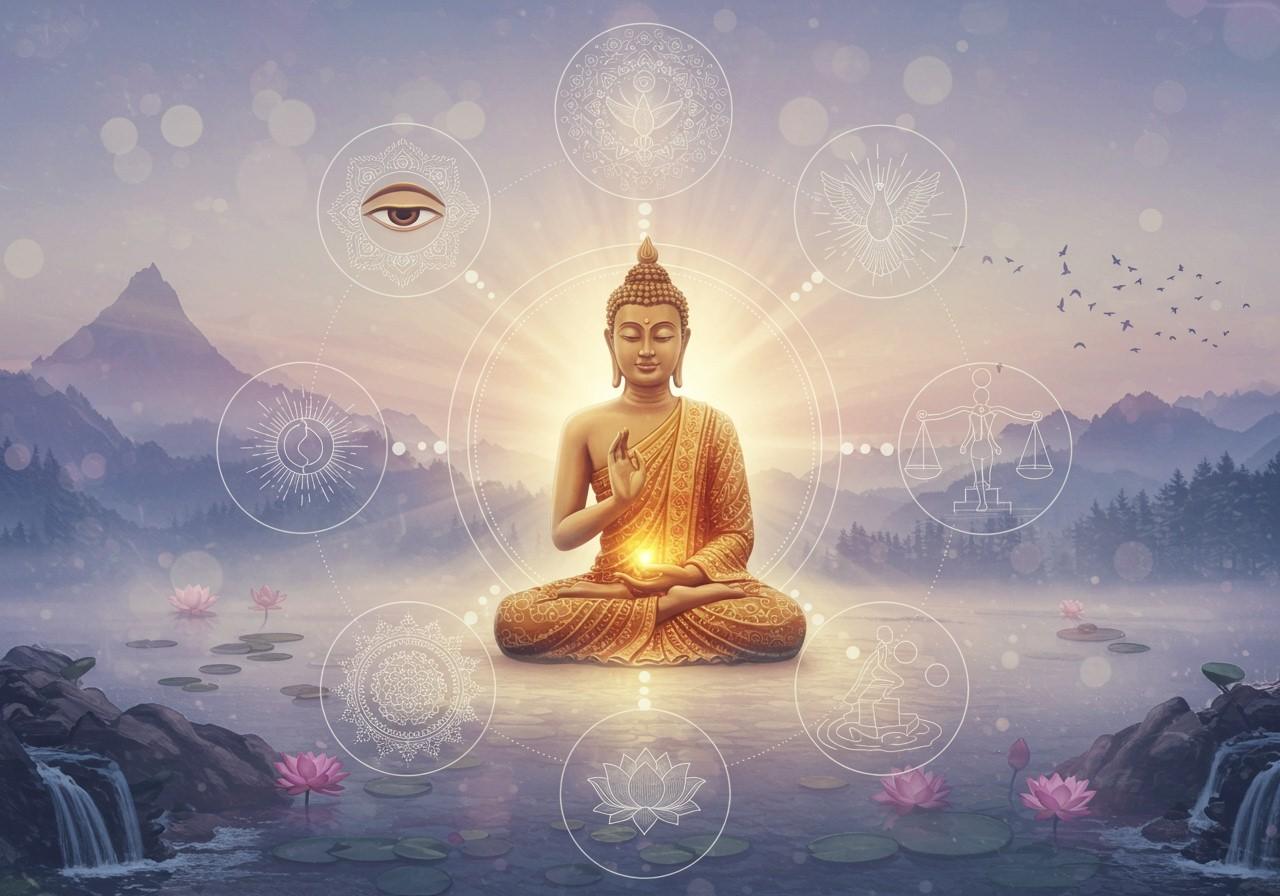
Buddhism, a timeless spiritual tradition, offers profound wisdom on the nature of reality and the path to liberation. At its core lies the Eightfold Path, a practical framework for cultivating ethical conduct, mental discipline, and wisdom. This guide explores the Eightfold Path, its significance, and how to integrate it into your life.
Origins and Significance
The Eightfold Path originates from the teachings of Siddhartha Gautama, the Buddha. During his quest for enlightenment, he realized this path as a means to overcome suffering (samsara) and achieve liberation (nirvana). Rooted in the Four Noble Truths, which elucidate the nature of suffering and its cessation, the Eightfold Path provides a structured approach to spiritual development. It represents a balanced middle way, avoiding the extremes of asceticism and sensual indulgence, as taught by the Buddha in his first sermon after enlightenment.
The Eight Components
The Eightfold Path comprises eight interconnected elements, forming a holistic guide to thought and action:
- Right Understanding (Samma Ditthi): Cultivating a clear comprehension of reality, based on the Four Noble Truths, impermanence, and interconnectedness. This involves understanding the causes of suffering and the path to liberation.
- Right Thought (Samma Sankappa): Nurturing thoughts of loving-kindness, compassion, and non-violence. This involves abandoning harmful thoughts of greed, aversion, and delusion.
- Right Speech (Samma Vaca): Speaking truthfully, kindly, and avoiding gossip or harsh language. This involves using words to promote harmony and understanding.
- Right Action (Samma Kammanta): Acting ethically and morally, refraining from harming others or engaging in harmful behaviors. This includes observing the five precepts: abstaining from killing, stealing, sexual misconduct, lying, and intoxicants.
- Right Livelihood (Samma Ajiva): Choosing a profession that aligns with ethical principles and does not harm others. This means avoiding occupations that involve exploitation, violence, or the sale of harmful products.
- Right Effort (Samma Vayama): Cultivating wholesome mental states and abandoning unwholesome ones. This involves actively nurturing positive qualities like mindfulness, concentration, and wisdom.
- Right Mindfulness (Samma Sati): Developing a heightened awareness of one’s thoughts, feelings, sensations, and surroundings. This involves paying attention to the present moment without judgment.
- Right Concentration (Samma Samadhi): Developing deep focus and mental stability through meditation. This involves training the mind to become calm, clear, and concentrated.
The Role of Meditation
Meditation is integral to the Eightfold Path, particularly for cultivating Right Mindfulness and Right Concentration. Various meditation techniques, such as mindfulness meditation (Vipassanā) and concentration meditation (Samatha), can be practiced. Start with short sessions and gradually increase the duration. Patience and consistency are key to overcoming challenges. Meditation helps reduce stress, enhance well-being, and develop mental clarity.
Eight Auspicious Symbols
Buddhism features eight auspicious symbols, each rich in meaning:
- Lotus Flower: Symbolizes purity and spiritual awakening.
- Endless Knot: Represents the interconnectedness of all things and the eternal nature of the Dharma.
- Two Golden Fish: Symbolize freedom from suffering and the abundance of spiritual blessings.
- Conch Shell: Represents the sound of the Dharma spreading far and wide, awakening beings from ignorance.
- Dharma Wheel: Symbolizes the Buddha’s teachings and the path to enlightenment.
- Victory Banner: Represents the victory over ignorance, attachment, and aversion.
- Parasol: Symbolizes protection from suffering and the blessings of the Three Jewels.
- Treasure Vase: Represents the inexhaustible wealth of the Dharma and the fulfillment of spiritual aspirations.
Applying the Eightfold Path in Modern Life
The Eightfold Path offers practical guidance for navigating modern life. Its principles can be applied to decision-making, relationships, and personal growth. Cultivating ethical conduct, mental discipline, and wisdom enhances all aspects of life.
Poojn.in: Supporting Your Buddhist Practice
Poojn.in offers a wide selection of items to support your Buddhist practice. Whether you are looking to enhance your meditation practice, create a serene space, or deepen your understanding of the Dharma, we have something for you.
- For Meditation (Right Mindfulness & Right Concentration):
Enhance your practice with our meditation cushions and mats, traditional singing bowls, and incense sticks and holders. These help you to create a peaceful and conducive environment for your meditation practice.
- Creating a Sacred Space (Right Effort):
Transform your home into a sanctuary with our Buddha statues, prayer flags, prayer wheels, and traditional lamps. These sacred objects can inspire and support your practice.
- Studying Buddhist Texts (Right Understanding):
Deepen your understanding of the Dharma with our book stands, prayer beads (mala), and Dharma wheels. We also offer storage boxes to protect your valuable texts.
Visit www.poojn.in to explore our complete collection. Our customer service team is always ready to assist you.
Embrace the Path to a Fulfilling Life
The Eightfold Path provides a timeless roadmap for a life of meaning and purpose. By embracing its principles, you embark on a transformative journey towards inner peace, wisdom, and liberation. Poojn.in is here to support you every step of the way.


